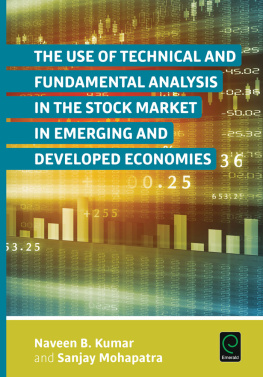Contents
The Use of Technical and Fundamental Analysis in the Stock Market in Emerging and Developed Economies
The Use of Technical and Fundamental Analysis in the Stock Market in Emerging and Developed Economies
By
Naveen B. Kumar
Indian School of Business, Hyderabad, India
Sanjay Mohapatra
Xavier Institute of Management, Bhubaneswar, India

| United Kingdom North America Japan
India Malaysia China |
Emerald Group Publishing Limited
Howard House, Wagon Lane, Bingley BD16 1WA, UK
First edition 2015
Copyright 2015 Emerald Group Publishing Limited
Reprints and permissions service
Contact:
No part of this book may be reproduced, stored in a retrieval system, transmitted in any form or by any means electronic, mechanical, photocopying, recording or otherwise without either the prior written permission of the publisher or a licence permitting restricted copying issued in the UK by The Copyright Licensing Agency and in the USA by The Copyright Clearance Center. Any opinions expressed in the chapters are those of the authors. Whilst Emerald makes every effort to ensure the quality and accuracy of its content, Emerald makes no representation implied or otherwise, as to the chapters suitability and application and disclaims any warranties, express or implied, to their use.
British Library Cataloguing in Publication Data
A catalogue record for this book is available from the British Library
ISBN: 978-1-78560-405-8
List of Tables
List of Charts
List of Abbreviations
ANOVA | Analysis of Variance |
APV | Adjusted Present Value Method |
BSE | Bombay Stock Exchange |
BV | Book Value |
DCF | Discounted Cash Flow Analysis |
DDM | Dividend Discount Models |
DMA | Displaced Moving Average |
EBITDA | Earnings before Interest, Tax, Depreciation and Amortization |
EMA | Exponential Moving Average |
EV | Enterprise Value |
EVA | Economic Value Added |
FTE | Flow to Equity Method |
GDP | Gross Domestic Product |
LCF | Levered Cash Flow |
MACD | Moving Average Convergence Divergence |
MV | Moving Average |
MVA | Market Value Added |
NOPAT | Net Operating Profit after Taxes |
NPVF | Net Present Value of Financing Side Effects |
NSE | National Stock Exchange of India Ltd. |
P/BV | Price to Book Value Ratio |
P/E | Price to Earnings Ratio |
PSR | Price to Sales Ratio |
PV | Present Value |
ROC | Rate of Change |
RSI | Relative Strength Index |
S & P | Standard and Poor |
SEBI | Securities and Exchange Board of India |
SES | Singapore Stock Exchange |
SMA | Simple Moving Average |
STII | Singapore Straits Times Industrial Index |
UCF | Unlevered Cash Flows |
WACC | Weighted Average Cost of Capital Method |
Abstract
A s in all financial markets, the primary question in the stock market is how market participants and stock traders forecast future market prices. The two general techniques for predicting stock market prices used by market professionals are chartist or technical analysis and fundamental or intrinsic value analysis. This study aims at finding out the usage of technical and fundamental analysis in the Indian stock market (emerging market) by brokers and the perceived importance attached to them by brokers.
CHAPTER
Introduction
How we value the stock market now and in the future influences major economic and social policy decisions that affect not only investors but also society at large, even the world. If we exaggerate the present value of the stock market, then as a society we may invest too much in business startups and expansions, and too little in infrastructure, education and other forms of human capital. If we think the market is worth more than it really is, we become complacent in funding our pension plans, in maintaining our savings rate, in legislating an improved social security system.
1.1. Securities Market in India: An Overview
The last decade (20002010) had been the most eventful period for the Indian securities market during which it took major strides to carve a niche for itself in the global securities markets. This section discusses origin, structure and the developments of the Indian securities markets and broader developments in the securities markets during 20002010.
1.1.1. ORIGIN OF INDIAN STOCK MARKET
The origin of the stock market in India goes back to the end of the eighteenth century when long-term negotiable securities were first issued. However, for all practical purposes, the real beginning occurred in the middle of the nineteenth century after the enactment of the Companies Act in 1850, which introduced the features of limited liability and generated investor interest in corporate securities.
An important early event in the development of the stock market in India was the formation of the Native Share and Stock Brokers Association at Bombay in 1875, the precursor of the present day Bombay Stock Exchange (BSE). This was followed by the formation of associations/exchanges in Ahmadabad (1894), Calcutta (1908) and Madras (1937). In addition, a large number of ephemeral exchanges emerged mainly in buoyant periods to recede into oblivion during depressing times subsequently.
Stock exchanges are intricacy inter-woven in the fabric of a nations economic life. Without a stock exchange, the saving of the community the sinews of economic progress and productive efficiency would remain underutilised. The task of mobilisation and allocation of savings could be attempted in the older days by a much less specialised institution than the stock exchanges. But as business and industry expanded and the economy assumed more complex nature, the need for permanent finance arose. Entrepreneurs needed money for long term, whereas investors demanded liquidity the facility to convert their investment into cash at any given time. The answer was a ready market for investments, and this was how the stock exchange came into being.














